

They also want to sell a portion of the energy produced by themselves in order to generate income. World's biggest sovereign wealth fund to ditch fossil fuels. The world’s largest sovereign wealth fund, which manages $1tn (£786bn) of Norway’s assets, has been given the go ahead for the largest fossil fuel divestment to date by dropping more than $13bn of investments.

Norway’s parliament voted plans into law on Wednesday for the fund to dump investments in eight coal companies and an estimated 150 oil producers. The divestment plan means the fund will drop coal investments worth an estimated $6bn, which could include shares in the mining companies Anglo-American, Glencore and the German energy firm RWE. The Government Pension Fund Global, which is built on Norway’s legacy oil earnings, will also move ahead with plans to scrap investments worth $7bn in oil exploration and production companies. It will, however, retain stakes in oil companies which are limiting their exposure to fossil fuels by investing in clean energy technologies.
These include BP and Shell, but rule out London-listed North Sea companies including Premier Oil and Tullow Oil. Infographic: the outlook for self-generation - Future Present. Strom direkt vom Erzeuger. A Microgrid Grows in Brooklyn. Energy, democracy, community – John Duda – Medium. How can we build a transition to renewable energy that doesn’t leave the already marginalized behind?
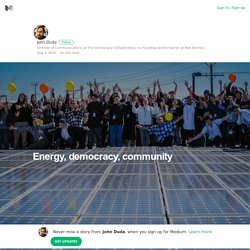
A story from Baltimore In 2009, the residents of Curtis Bay—a multiracial, working class neighborhood on Baltimore’s industrial southern edge, learned that history was about to repeat itself. Energy crowdfunding: the new way to boost renewables. It's a brand new sector: the first steps date back to 2012.
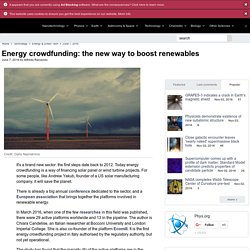
Today energy crowdfunding is a way of financing solar panel or wind turbine projects. For some people, like Andrew Yakub, founder of a US solar manufacturing company, it will save the planet. There is already a big annual conference dedicated to the sector, and a European association that brings together the platforms involved in renewable energy. The Cost Of Half A Billion Solar Panels Keeps Going Down, Down, Down. Posted Categories: Education It’s been one of the big themes at the World Energy Future Conference in Abu Dhabi.

Solar, and other technologies such as wind power, are no longer more expensive than traditional fossil fuels in many parts of the world. Indeed, they are cheaper. 50% of EU Residents Could Be Generating Their Own Renewable Energy by 2050. By Nadia Prupis A people-powered energy revolution—an era in which people can produce their own electricity—is possible, and could happen soon, according to a new report released Monday by the environmental group Friends of the Earth Europe (FOEE). birgstockphoto.com The report, The Potential of Energy Citizens in the European Union, finds that over half the residents of the EU could be generating their own renewable electricity by 2050.
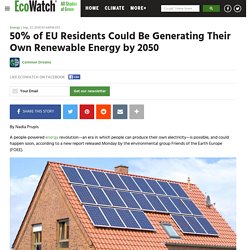
That's 264 million "energy citizens" meeting 45 percent of the region's energy demand through a democratized, citizen-owned system that allows people to be the operators of their own utilities—taking power away, in more ways than one, from a market monopolized by large corporations. Community-Owned Energy: How Nebraska Became the Only State to Bring Everyone Power From a Public Grid by Thomas M. Hanna. In the United States, there is one state, and only one state, where every single resident and business receives electricity from a community-owned institution rather than a for-profit corporation.

It is not a famously liberal state like Vermont or Massachusetts. Rather, it is conservative Nebraska, with its two Republican Senators and two (out of three) Republican members of Congress, that has embraced the complete socialization of energy distribution. In Nebraska, 121 publicly owned utilities, ten cooperatives, and 30 public power districts provide electricity to a population of around 1.8 million people. Public and cooperative ownership keeps costs low for the state’s consumers. The Battery Powered Home: A Global Transformation Is Under Way! (video)
Posted Categories: Energy In spite of the fact that millions of people around the world are looking to Solar Power as a solution to their utility expenses, different communities, cities, and counties have different rules about how to apply the power you produce to the local grid system, and at what cost they buy it back from you.

As seen in the following video, all too often, when you overproduce power, you are paid 1/4 of the price you pay when you use their power, and net-metering is not fairly applied to production. For that reason, better home battery systems have been the holy grail for solar power producers. Small-Town Solar Revolution Has Created Jobs Galore & Driven Down Price of Power in Germany. Clean Power Published on March 19th, 2012 | by Zachary Shahan Solar energy policies in Germany have resulted in a jobs boom and have driven down the price of power on the EPEX Power Exchange.
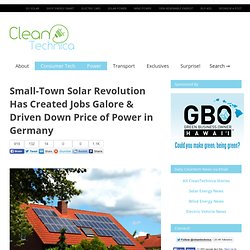
More people work in Germany’s solar energy sector than in its coal and nuclear sectors combined. (Don’t tell this year’s GOP candidates — they somehow think clean energy and green jobs is all just talk.) Homegrown Green Energy Is Making Power Utilities Irrelevant. There are 3,200 utilities that make up the U.S. electrical grid, the largest machine in the world.
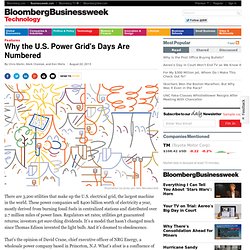
These power companies sell $400 billion worth of electricity a year, mostly derived from burning fossil fuels in centralized stations and distributed over 2.7 million miles of power lines. Regulators set rates; utilities get guaranteed returns; investors get sure-thing dividends. Energy Democracy: Building a Solar Dream in a Tar Sands Nightmare.
In a community of five hundred people in northern Alberta, a 20.8 kW solar installation has been set up to power the First Nation's health centre, and put additional energy back in to the grid.

The Indigenous community of the Lubicon Cree used to be self-sufficient and was able to live off the land. Now the community deals with contaminated water, polluted air and a compromised landscape. In 2011, the community dealt with one of the largest oil spills in Alberta's history. After dealing with three decades of intensive oil, gas, logging, fracking and tar sands exploitation in our homeland, my community of Little Buffalo has chosen to forge a new future and become powered by the sun.
Leben mit der Energiewende 3 - Selber machen - Der Kinofilm. Solar PV and wind are on track to replace all coal, oil and gas within two decades. Solar photovoltaic and wind power are rapidly getting cheaper and more abundant – so much so that they are on track to entirely supplant fossil fuels worldwide within two decades, with the time frame depending mostly on politics. The protestation from some politicians that we need to build new coal stations sounds rather quaint. The reality is that the rising tide of solar photovoltaics (PV) and wind energy offers our only realistic chance of avoiding dangerous climate change.
No other greenhouse solution comes close, and it is very hard to envision any timely response to climate change that does not involve PV and wind doing most of the heavy lifting. Read more: Solar is now the most popular form of new electricity generation worldwide About 80% of Australia’s greenhouse gas emissions are due to the use of coal, oil and gas, which is typical for industrialised countries. PV and wind have minimal environmental impacts and water requirements. A renewable grid. People love renewable energy, so why don't politicians get it? New EWG study: International Energy Agency holds back global energy transition. Press Release New EWG study: International Energy Agency holds back global energy transition Energy Watch Group and Lappeenranta University of Technology analysis shows that the IEA has consistently undermined potential of solar and wind energy in the last decade.
Renewable energy sacrificed on the altar of corporate profit. Is the real problem with solar and onshore wind power not that it's costing us too much, but the very reverse - that it's costing far too little - and sharply cutting away at power company profits? The Government's 'war on renewables' makes no sense. That's what plenty of people are telling you, and on the face of they are completely right. Take onshore wind power. Onshore wind is by far the UK's lowest cost source of renewable power capable of delivering on a large scale. Who are the Renewable Energy Foundation? It's our choice: renewable energy superpower or Asian Pacific rust belt. Investors' neglect of small-scale renewables threatens universal energy access. Investing in a large-scale wind farm is a better guarantee of profits than multiple, small, off-grid renewables projects but without the latter, argues a recent report, the sustainable development goal of low-carbon energy access for all will never be met.
It is estimated (pdf) close to $50bn a year is needed to achieve universal access to electricity and clean cooking facilities by 2030.